Course:FNH200/2012w Team19 Chocolate
Chocolate Truffle Making
Introduction
History of Truffle Making
The history of chocolate truffles begins in the early 1800’s with the invention of the cocoa press, an instrument used to remove cocoa butter from the cocoa bean producing a solid bar of chocolate. The availability of solidified chocolate was the key catalyst in many chocolate dessert recipes known today. It was about fifty years after this invention that French chocolate producers discovered that when melted chocolate and cream are mixed together it can form a rich and velvety texture, which we have come to know as ganache. When ganache is thoroughly chilled it becomes easily malleable, and thus became the main constituent of chocolate truffles. Due to the appearance of the original chocolate truffle, a round velvety chocolate ball covered in cocoa powder, it was named after the subterranean fungus that grows at the bottom of trees in France. Initially, chocolate truffles were expensive to purchase and were consumed only by Royalty and wealthy individuals. However as chocolate producers worldwide began producing truffles, the price of this confection became affordable, and also varied in flavour and constituents.[1]
-
Truffle Mushrooms
-
Chocolate Truffles
What are Truffles
There are two very different types of truffles, one that is a subterranean mushroom, which is usually found at the base of trees in Europe, and the other is a creamy chocolate rolled into a little ball covered with a topping. This article is on the latter of the two. Chocolate Truffles are a mixture of bittersweet chocolate (or semi-sweet chocolate) and heavy cream melted and blended together to form a thick chocolate emulsion in milk, also known as a ganache. Ganach has many uses depending on its consistency, which correlates to how much cream is used in the processing. When the ratio of cream is more then the amount of chocolate, a smooth and easily malleable consistency is achieved, and this chocolate cream consistency may be used for icing cakes. A slightly lesser amount of cream can provide a more firm texture of ganache that is used in dessert fillings. When the amount of chocolate equals the amount of milk the ganache can then be chilled, rolled into a small ball, and topped with cocoa powder, chopped nuts, or any dry topping that compliments chocolate, forming a truffle.
The Recipe
The Science Behind Truffle Making
Truffles are traditionally made with a chocolate ganache centre that can have a variety of external coating and flavours. The ganache is a complex emulsion of cocoa butter fat droplets and solid cocoa particles from the chocolate suspended in the aqueous phase of the cream.[2] Essentially, melting finely and evenly chopped chocolate with hot cream makes the emulsion of a ganache.
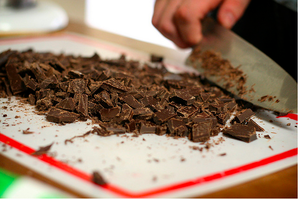
After pouring the hot cream over the chocolate, allow the mixture to sit undisturbed to ensure a slow and steady melting process, as well as bringing down the temperature. A temperature between 32-44˚C yields better emulsion formation. This temperature must be carefully controlled; otherwise the resulting ganache will not be smooth. [3] Lumpy ganache may also result from uneven chocolate pieces since the smaller pieces will melt first while the bigger pieces remain unmelted. The reason why the chocolate should be chopped into small pieces is so that melting can take place faster and at a lower temperature. The faster the ganache is emulsified, the better the resultant finishing texture and appearance.[4] Additional heat may be applied to the ganache to melt remaining unmelted chocolate pieces, but the bigger the chocolate, the more heat must be applied, which may cause fat to overheat and pool and subsequently breaking the ganache. The emulsion is completed through mechanical stirring that breaks down the cream and chocolate fat into microscopic drops that can be suspended in the water phase of the cream. Emulsifiers, such as lecithin used by chocolate manufacturers stabilize the system and keep the system as an emulsion.
Flavoured Variants of the Truffle Recipe
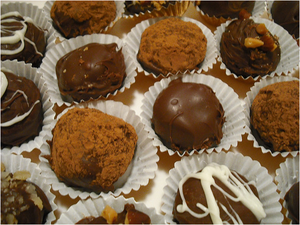
Once the ganache has been thoroughly chilled it may be scooped and formed into a variety of shapes, or pressed into molds then coated with a topping of choice such as cocoa power, chocolate nibs, or nuts. The toppings not only serve the purpose of adding to the flavour or appearance of the truffle, but it also makes it easier for the consumer to pick up with his/her hands. Without a topping the velvety chocolate ball would easily slip out of the fingers of the person consuming it. The ganache may also be flavoured to produce a variety of truffles. Herbs, spices, coffee beans and tea leaves may be infused into the cream during the heating process, then strained before mixing into the chocolate to provide flavours such as lavender, mint, tea, and coffee. Flavoured liquids such as liqueurs, extracts, fruit purees, and brandy may be added to a warm ganache to provide additional flavours as well. Varying the amount of fat in the recipe will change the creaminess of the ganache. A higher fat content will produce a richer ganache, and lower one will have the opposite effect.[5]
Effects of Temperature on Chocolate Ganache
Temperature plays a crucial role in ganache formation, which ultimately equates to making the perfect truffle. The ganache can be refrigerated for varying amounts of time depending on purpose. Longer refrigeration time will result in a firmer and harder ganache. If the ganache is cooled too quickly it may become dry or cracked, or if the ganache is over heated the oils from the chocolate will separate and coagulate at the surface. Both of these situations will result in a duller and drier ganache and hence a duller looking truffle if left uncoated. Separation with the ganache may also occur if it is refrigerated immediately after processing and cooled too quickly. A slow cooling process allows the chocolate and cream molecules to bond securely thereby providing the finished ganache with an aesthetically appealing shine.[6] Additionally, if the ganache is left in the refrigerator for an extended period of time then removed, the sugar dissolves in the water condensation formed on the ganache. This sugar will then surface as the water evaporates and will crystallize on the surface of the chocolate. An unappetizing appearance and texture known as sugar blooms will result.[7]
Team 19's Cooking Tutorial
The following is a cooking tutorial we made on how to make chocolate truffles.
Effects of Characteristics Depending on the Modification of the Cooking Process
There are hundreds of recipes one can use to make a delicious chocolate truffle, and each recipe will give this delicacy a slight variation in its texture and/or flavour. In making chocolate truffles, the ganache formation is what will ultimately be the truffle filling, and is the most important process because the ganache determines the texture of the final product, and this is where most variations can happen.
Creme to Chocolate Ratio of Ganache
The cream to chocolate ratio is a significant determinant of what the final product will be like. Different ratios will provide different textures to the ganache, which will subsequently have an effect on the mouthfeel. The use of the ganache for different products will also determine the cream to chocolate ratio used.
Creme to Chocolate Ratio and Texture/Usage
| Ratio of Creme:Chocolate | Ganache Texture/Usage |
|---|---|
| 1:1 | Very smooth, creamy ganache, may be used for moulding, but will have a very short shelf life of about two weeks |
| 1:1.5 | Very smooth and easily malleable, may be used for moulding and icing |
| 1:2 | Very soft, but now it resembles more of a solid than liquid, may be used for moulding and piped truffles |
| 1:2.5 | Ganache is quite sturdy and is able to maintain its shape, can be cut with special cutter or knife (e.g. butter knife) |
| 1:3 | A definite solid, but still relatively easy to cut |
| 1:4 | Ganache turns quite firm and dry, generally not used to make chocolate-related food products |
Effects of Altering the Ingredients
Butter

Butter is one of the main ingredients in ganache. It is often coupled with cream to facilitate the melting of chocolate, and sometimes it can even replace the cream to decrease the moisture content and to extend the shelf life of ganache.[5] Cream usually contains around 60 - 65% water, while butter only has 18% moisture content, and as discussed in the FNH 200 class, this lowered water activity limits the growth and division of microorganisms which can help preserve the ganache. [5] Replacing cream with butter creates a ganache that is smooth, however not easily transferable from bowl to bowl, which is a necessary in truffle making procedure, therefore a mixture of butter and cream is often used.
Corn Syrup or Invert Sugar
Some recipes call for the addition of corn syrup or invert sugar when heating the butter or cream, or both.[7] From the Lesson 2 lecture notes in the FNH 200 class, corn syrup, unless high in fructose (HFCS), is less sweet than sucrose, while invert sugar, which is the breakdown of sucrose into fructose and glucose via invertase or acid, is sweeter than sucrose. Nevertheless, adding either will make the chocolate taste sweeter. Also from Lesson 2 course notes, adding sugars can help lengthen the shelf life of a product, since sugars can limit microbial growth by binding to the free water which lowers the water activity. Below a certain water activity, microorganisms will not be able to grow or survive. This is also true for the ganache in truffles.
Double Boiling Technique - Its Pros and Cons
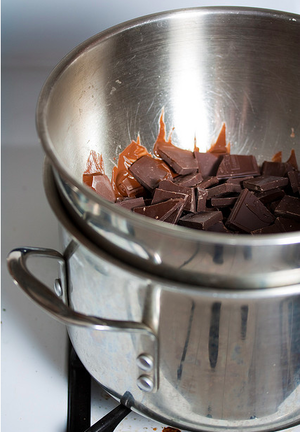
Regardless of the method, melting chocolate must occur in the making a delicious ganache. The melting of chocolate can be a very delicate process, and one mistake can cause whole batch to be thrown away. The most favoured technique is double boiling process. This process consists of a large heat resistant bowl, where the chocolate will melt in, sitting atop a saucepan, which is smaller in diameter to the bowl, filled one-third with boiling water. The heat generated from the boiling water heats the bowl with the chocolate causing it to melt indirectly, and thus avoiding over heating the chocolate.[8] The disadvantages to using the double boiling technique is that firstly, the melting process requires undivided attention to the bowl throughout the heating process, which usually takes some time. Secondly, if a little steam from the boiling water condenses and falls into the ganache, its flavour and consistency may be altered. [8] Nevertheless, the double boiling technique is a very simple method with more control over melting temperature and time. [8] Also, water dripping into the ganache can usually be carefully avoided.
The Ingredients
Chocolate
The main ingredient chocolate, acts as flavouring and is one of the determinants of the texture of truffles. The more cocoa butter present in the chocolate, the firmer the truffles will be. A regular chocolate candy bar contains low cocoa solids and low cocoa butter and can result in an unstable mix. Bakers chocolate contains a higher content of cocoa solids and cocoa butter, which makes it a preference for cooking.[9] For use in truffle recipes, the chocolate should be chopped into small, and even pieces to ensure a smooth melting process when the hot cream is added.
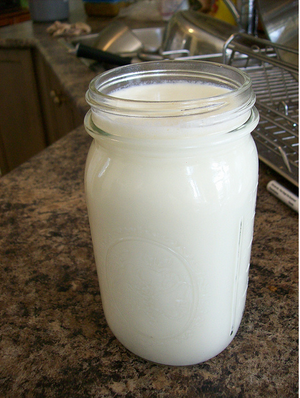
Whipping Cream
Upon the addition of hot whipping cream to the chocolate, the cocoa butter and butter fat become suspended in the cream forming an emulsion.[9] The texture and consistency of this emulsion is affected by the ratio of chocolate to whipping cream. The whipping cream adds a lot of fat to the mixture due to its high milk fat content of between 30% and 36%. Equal parts chocolate and whipping cream will result in a very smooth texture but a short shelf life. The more chocolate added, the firmer the centre and the longer the shelf life.[5]
Tempering
The right temperature when melting the chocolate is crucial to ensure that all of the melted cocoa butter crystallizes into the same type of crystal in order achieve smooth, glossy and crisp chocolate in the truffles.[9] The best type of cocoa butter crystal is type V which are achieved through tempering which consists of melting and cooling the mixture at various specific temperatures.[10]
Other Additives
A moisture stabilizer, such as corn syrup, can be added to prevent the mix from becoming over-saturated. If not enough water is present and the solution is saturated, and the sugar will crystallize too quickly resulting in a hard mix.[5] During stirring, air is introduced into the mixture, which cause the fat to oxidize, which negatively affects flavour. Therefore stirring should be kept to a minimum while still evenly distributing the ingredients in the mixture. Another truffle additive is flavouring such as vanilla extract, or liqueur, which is added to the mixture during processing to enhance flavour.[11]
Canadian Regulation of Truffles and Chocolate Products
By Canadian definition, truffles are correctly labelled as a “chocolate product” because it is a food item derived from semi-sweet chocolate, which itself is derived from cocoa products. [12]
However, there is no Canadian regulation on what ingredient compositions are required for a food to be legally labelled as a chocolate truffle.
On the other hand, the regulation on semi-sweet and bittersweet chocolate is heavily regulated. To be legally classified as semi-sweet or bittersweet chocolate, the product must contain the following qualities[12]:
- (a) shall be one or more of the following combined with a sweetening ingredient, namely,
- (i) cocoa liquor,
- (ii) cocoa liquor and cocoa butter, and
- (iii) cocoa butter and cocoa powder;
- (b) shall contain not less than 35 per cent total cocoa solids, of which
- (i) not less than 18 per cent is cocoa butter, and
- (ii) not less than 14 per cent is fat-free cocoa solids; and
- (c) may contain
- (i) less than 5 per cent total milk solids from milk ingredients,
- (ii) spices,
- (iii) flavouring preparations, other than those that imitate the flavour of chocolate or milk, to balance flavour,
- (iv) salt, and
- (v) any of the following emulsifying agents, which singly shall not exceed the maximum level of use set out in column III of Table IV to section B.16.100, and in combination shall not exceed 1.5 per cent by mass of chocolate product, namely,
- (A) mono-glycerides and mono- and diglycerides,
- (B) lecithin and hydroxylated lecithin,
- (C) ammonium salts of phosphorylated glycerides,
- (D) polyglycerol esters of interesterified castor oil fatty acids, and
- (E) sorbitan monostearate.
The Characteristics
The ganache centre distinguishes the chocolate truffle from all other chocolate confections. A ganache is characterized by an emulsion between a chocolate and a liquid, with a fat content of 40% recommended in order to achieve a high quality product.[5] The emulsification takes place as the cream is heated, which reduces the water content. In order to achieve the smooth consistency that is desired for a truffle, the ganache must be precrystallized.[5] Precrystallisation refers to a technique that incorporates important factors of temperature and time to attain an optimal consistency. Through this process, chocolate is heated and cooled under controlled temperatures and finally brought to the desired temperature in order to reach a favourable consistency.[13] Prescrystallization of the ganache ensures a finer texture as well as a longer shelf life.[5] Stirring completes the emulsion, however it is important not to over stir the ganache as it will oxidize the milk fat and cocoa butter, resulting in a loss of flavour and deteriorated shelf life.[5] To ensure a smooth texture, the chocolate should be stirred carefully, otherwise the molecules can separate too quickly which can render a poor quality chocolate that is crumbly in texture.[14] The process of stirring serves to break down the fat in the chocolate and cream to droplet sizes that are small enough to be suspended in water. To ensure a good quality ganache, avoid water dripping into the mixture. If chocolate absorbs moisture, fats and sugar crystals rise to the surface, leading to an oily texture.[14]
Nutritional Value
The nutritional value of a chocolate truffle will vary depending on the recipe used. Overall, chocolate truffles have low nutritional value and are grouped in the “Fats, Oils and Sweets” of the Food Guide Pyramid. It is recommended that chocolate truffles be consumed sparingly.[15]
Calories, Fat, Cholesterol and Sodium
Typically, one serving of truffles is 12g in weight and ranges from 60 to 100 calories. The total fat content ranges from 4g to 6g of fat, and most of the fat is in the form of saturated fat. Cocoa beans produce a high fat content, approximately 54% fat, thus it is considered a fattening food. The high fat content present in the truffle imparts the sensation of satiety after consumption. However, it is important for good health to avoid too much fat, especially saturated fat, in our diet. It is recommended to limit saturated fat intake to less than 7 percent of total daily calories[16], and unfortunately chocolate truffles are high in both fats and calories.
Carbohydrates and Protein
Generally, one serving of truffles contains approximately 5g of carbohydrate and 1g of protein.[17] Truffles are approximately 10g to 15g in sugar, which is considered to be an indulgence that is high in sugar. Since sugars are not considered a nutrient, they provide no nutritional value. Based on a 2000 daily calorie diet, the USDA recommends 32g of added sugar consumption[18], which translates to no more than 10 to 15 percent of one’s daily caloric intake. Protein is a vital nutrient that is essential for growth and is recommended to be obtained from both animal and other protein sources.[18] Chocolate truffles are a poor source of protein as they contain only about 1g of protein and do little to satisfy the FDA recommended daily intake of 50g of protein per day. [19]
Vitamins and Minerals
Overall, chocolate truffles are a poor source of vitamins and minerals. Truffles contain a minute amount of calcium and iron, providing only 2 to 4 percent of the recommended daily intake of calcium and 2 to 4 percent of iron. Interestingly, pure cocoa beans provide a multitude of health benefits and are a great source of several vitamins and minerals, however as they are fermented and roasted to become chocolate they lose much of their nutritional value.[20]
Conclusion
The chocolate truffle is not only the perfection of the art of chocolate making, it is also the result of precise scientific interactions and properties.
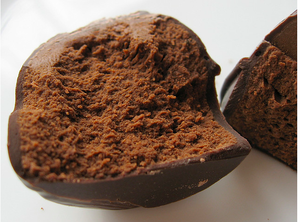
Variations in the recipe not only increases the variety and flavors available to suit the taste of a wide range of consumers, the different cooking methods and ingredients of varying recipes will also affect the truffle's texture, creaminess, nutrition content and shelf life. Truffles made with more fat content in the cream or with a higher cream to chocolate ratio will be creamier and smoother. Recipes that use ingredients with more water content, such as whipping cream, will lead to an overall shorter shelf life as microorganisms will be able to grow in the water content. Hence, the use of more butter will not only lead to a smoother truffle, but also an increased shelf life. However, the liquid to solid ratio must still be carefully controlled in order to keep the emulsion intact and transferable. Carefully controlling heating and cooling as well as sugar content and storage conditions will lead to a better quality and more shelf stable product. In conclusion, this project has shown us the versatility of chocolate and the intricate science that gives rise to all of its properties. Further experiments that could be explored in regards to this topic would be to try making truffles using different types of chocolate, for example, white chocolate or milk chocolate and seeing how the different cocoa and fat content affects the end result if the same method and cream ratios were used. Another experiment could be varying heating or cooling rates and exploring how the differing rates affect the overall product.
Interesting Facts
The chocolate truffle was coined “Truffle” due to the physical similarities it possesses with the wild mushroom truffle.[21]
The chocolate truffle was created in the 1920’s by the famous French culinary artist, Auguste Escoffier.[21]
The chocolate truffle was first introduced in France and was associated with wealth and high status.[22]
There are three forms of truffles: American, European, and Swiss.[22]
Exam Question
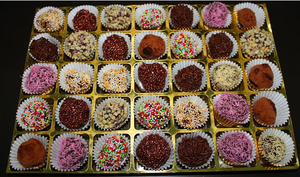
Billy was delighted when he received a box of truffles for Christmas, because there were so many different flavours and he could have the whole box to himself. In trying to make the truffles last as long as possible, Billy decided that he would eat only one per week. Comparing a standard chocolate powdered truffle to a strawberry cream filled truffle consisting of a strawberry syrup center within the ganache filling, which one should Billy eat first if considering shelf life stability? Assume all other conditions are held constant and the ganache quality is the same.
References
- ↑ Hamiltions Chocolates. 2010. The history of the chocolate truffle Retrieved March 24, 2013 from http://www.hamiltons-chocolates.co.uk/khxc/gbu0-newsshow/chocolate_truffles_history.html
- ↑ Phillips, S (2000). Ganache. Retrieved from http://baking911.com/learn/baked-goods/chocolate/types/ganache
- ↑ Yard,S. (2003) The Secrets of Baking: Simple Techniques for Sophisticated Desserts. New York, NY: Houghton Mifflin Company.
- ↑ Tibballs, K (2010). Cooking Tips From Bulla Ambassador Kirsten Tibballs. Retrieved from http://www.bullafoodservice.com.au/bulla-ambassador-kirsten-tibballs/398.html
- ↑ 5.00 5.01 5.02 5.03 5.04 5.05 5.06 5.07 5.08 5.09 Wybauw, J. P. (2007). Fine Chocolates: Great Experience. Retrieved from http://books.google.ca/books?id=P-hFBMEBLBAC&pg=PA114&lpg=PA114&dq=ganache+crystallisation&source=bl&ots=d3anOG4NF4&sig=TDvIrebF9H6sJ9bN3JvjaWVnOuQ&hl=en&sa=X&ei=5q5IUauaI-HsigLtmoCIDg&ved=0CEkQ6AEwBA#v=onepage&q=ganache%20crystallisation&f=false
- ↑ Allrecipes (n.d.) retrieved from http://allrecipes.com/howto/chocolate-ganache/
- ↑ 7.0 7.1 The Chocolate Doctor (n.d.) Q and A. Retrieved March 22, 2013, from http://www.thechocolatedoctor.ca/q-and-a.html
- ↑ 8.0 8.1 8.2 Davis, A. (2011). How to melt chocolate. Retrieved Mar 22nd, 2013 from http://www.lovefood.com/journal/features/11381/the-best-way-to-melt-chocolate--
- ↑ 9.0 9.1 9.2 Brown, Alton. Good Eats: Art of Darkness. Retrieved on March 20, 2013 from https://www.youtube.com/watch?v=cLRP5nNG2W4
- ↑ LaBau, Elizabeth. How to Temper Chocolate. Retrieved March 20, 2013 from http://candy.about.com/od/candybasics/ht/temperchoc.htm
- ↑ The Dairy Council. Varieties of Milk. Retried March 20, 2013 from http://www.milk.co.uk/page.aspx?intPageID=43
- ↑ 12.0 12.1 Government of Canada. (2013). Food and Drug Regulations. Retrieved from http://laws.justice.gc.ca/eng/regulations/C.R.C.,_c._870/FullText.html
- ↑ Matcha chocolat artisan chocolates. 2010. A Guide to Tempering Chocolate. Retrieved on March 26, 2013, from http://matchachocolat.com/recipes/a-guide-to-tempering-chocolate/
- ↑ 14.0 14.1 A, WB. 2012. Truffle making. Retrieved on March 22, 2013, http://chocolate.mit.edu/~chocolatiers/Wiki/index.php?title=Truffle_Making
- ↑ Kecskemethy, H. 2001. The Food Guide Pyramid. Santa Clara University. Retrieved on March 25, 2013, from http://www.scu.edu/wellness/topics/nutrition/foodpyramid.cfm
- ↑ American Heart Association. 2012. Know Your Fats. Retrieved on March 25,, 2012, from http://www.heart.org/HEARTORG/Conditions/Cholesterol/PreventionTreatmentofHighCholesterol/Know-Your-Fats_UCM_305628_Article.jsp
- ↑ V, L. Nutrition Facts for Lindor Truffles. Retrieved on March 25, 2012, from http://www.livestrong.com/article/315607-nutrition-facts-for-lindor-truffles/
- ↑ 18.0 18.1 Discovery, Fit and Health. 2013. USDA Sugar Guidelines. Retrieved on March 25, 2013, from http://health.howstuffworks.com/wellness/food-nutrition/facts/usda-sugar-guidelines-ga.htm
- ↑ Mack, S. 2011. FDA Daily Recommendations for Protein. Retrieved on March 23, 2013, from http://www.livestrong.com/article/465184-fda-daily-recommendations-for-protein/
- ↑ Perryman, S. 2013. Go Ahead, Chocoholics, A Little Chocolate Is Good For You. Retrieved on March 21, 2013, from http://www.ext.colostate.edu/pubs/columnnn/nn120211.html
- ↑ 21.0 21.1 Hochman, K. 2007. Lifestyle Direct. History of Truffles. Retrieved on March 25, 2013http://www.thenibble.com/REVIEWS/Main/chocolate/chocolate-truffle-history.asp
- ↑ 22.0 22.1 O’Malley, A. 2008. Chocolate Truffles- A Long and Delicious History. Retrived on March 24, 2013, from http://www.articlesbase.com/chocolate-articles/chocolate-truffles-long-and-delicious-history-624799.html

